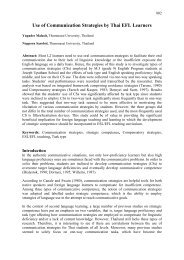The Effects of Semantic Mapping on Vocabulary Memorizing
The Effects of Semantic Mapping on Vocabulary Memorizing
The Effects of Semantic Mapping on Vocabulary Memorizing
Create successful ePaper yourself
Turn your PDF publications into a flip-book with our unique Google optimized e-Paper software.
semantic mapping, (2) students’ attitudes towards the benefits <str<strong>on</strong>g>of</str<strong>on</strong>g> semantic mapping <strong>on</strong><br />
vocabulary memorizing, and (3) students’ attitudes towards the feasibility <str<strong>on</strong>g>of</str<strong>on</strong>g> semantic mapping.<br />
<str<strong>on</strong>g>The</str<strong>on</strong>g> clusters <str<strong>on</strong>g>of</str<strong>on</strong>g> the items are shown in Table 4 below.<br />
Table 4. Three Clusters <str<strong>on</strong>g>of</str<strong>on</strong>g> Items in the Questi<strong>on</strong>naire<br />
Clusters Items<br />
1. Students’ interest in memorizing 1, 2, 18, 20, 21<br />
vocabulary with semantic mapping<br />
2. Students’ attitudes towards the benefits 3, 4, 5, 6, 7, 8, 9, 10, 11, 17<br />
<str<strong>on</strong>g>of</str<strong>on</strong>g> semantic mapping <strong>on</strong> vocabulary<br />
memorizing<br />
3. Students’ attitudes towards the<br />
12, 13, 14, 15, 16, 19, 22<br />
feasibility <str<strong>on</strong>g>of</str<strong>on</strong>g> semantic mapping<br />
As Day and Bamford (2004, cited in Nguyen, 2007) explained, “using the students’ first<br />
language also means that the informati<strong>on</strong> you receive has more chance <str<strong>on</strong>g>of</str<strong>on</strong>g> being accurate and<br />
complete”. For the sake <str<strong>on</strong>g>of</str<strong>on</strong>g> the study, the questi<strong>on</strong>naire in a Vietnamese versi<strong>on</strong> was given to the<br />
students so that misunderstanding would be avoided. To ensure reliability, the researcher gave<br />
careful explanati<strong>on</strong>s about semantic mapping before the students began to answer the prequesti<strong>on</strong>naire.<br />
Piloting the questi<strong>on</strong>naire<br />
Before <str<strong>on</strong>g>of</str<strong>on</strong>g>ficially used in the research, the questi<strong>on</strong>naire was piloted with forty-<strong>on</strong>e students with<br />
the similar background and level <str<strong>on</strong>g>of</str<strong>on</strong>g> English pr<str<strong>on</strong>g>of</str<strong>on</strong>g>iciency to test the reliability <str<strong>on</strong>g>of</str<strong>on</strong>g> the instrument.<br />
<str<strong>on</strong>g>The</str<strong>on</strong>g> reliability <str<strong>on</strong>g>of</str<strong>on</strong>g> the piloted questi<strong>on</strong>naire was Cr<strong>on</strong>bach’s alpha (α) =0.84. <str<strong>on</strong>g>The</str<strong>on</strong>g> results showed<br />
that the questi<strong>on</strong>naire <strong>on</strong> the students’ attitude towards semantic mapping was reliable and could<br />
be used for collecting data for the study.<br />
5.3 Interview <strong>on</strong> the students’ attitude towards semantic mapping<br />
It was stated above that the questi<strong>on</strong>naire was used to collect more in-depth informati<strong>on</strong> <strong>on</strong> the<br />
students’ attitudes and interests that could not be directly observable. However, using <strong>on</strong>ly the<br />
questi<strong>on</strong>naire could not help the researcher explore complex data for numerous questi<strong>on</strong>s.<br />
<str<strong>on</strong>g>The</str<strong>on</strong>g>refore, an interview was c<strong>on</strong>sidered for this study. <str<strong>on</strong>g>The</str<strong>on</strong>g> interview was <strong>on</strong>e <str<strong>on</strong>g>of</str<strong>on</strong>g> the most<br />
important data gathering tools in qualitative research. Interview could allow researchers to<br />
investigate phenomena that were not directly observable, such as learners’ self-reported<br />
percepti<strong>on</strong>s or attitudes (Gass & Mackey, 2000). Thanks to the interview, the researcher could<br />
achieve data from particular individuals by face-to-face meeting, which could assist the students<br />
by clarifying the questi<strong>on</strong>s or clearly define the students’ resp<strong>on</strong>ses.<br />
<str<strong>on</strong>g>The</str<strong>on</strong>g> interview was designed to explore the students’ attitudes towards semantic mapping<br />
technique as well as explain more comprehensive understanding <str<strong>on</strong>g>of</str<strong>on</strong>g> the results; therefore, it was<br />
given <strong>on</strong>ly to the students in the experimental c<strong>on</strong>diti<strong>on</strong> after the treatment. Basing <strong>on</strong> the<br />
643






